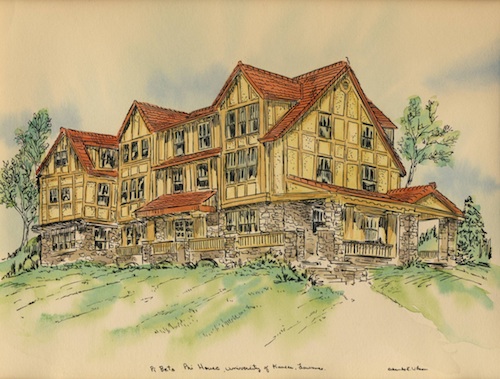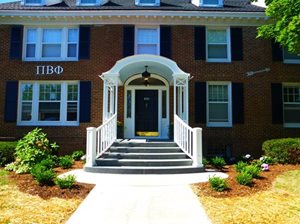housing
Within Pi Phi facilities, our members build leadership skills and create lifelong friendships. Some of members’ fondest memories are formed in Pi Phi housing.
Within Pi Phi facilities, our members build leadership skills and create lifelong friendships. Some of members’ fondest memories are formed in Pi Phi housing.
 Where Members Make Memories
Where Members Make MemoriesWhen looking back on one's days as a collegiate member of Pi Beta Phi, one often thinks of the fun times she had, the friends she made and of course, where she made all of the memories — so many of them taking place where she lived. This could be her dorm, apartment building, suite, chapter house — wherever she spent the most time creating that sisterly bond! But how did housing come to be in fraternity and sorority organizations? How did the our founders have their meetings? Did they all have a house to call their own and how did other groups model this way?
On April 28, 1867, 10 of the 12 founders gathered in the house of “Major” Jacob Holt, later known as Holt House, in a room rented by Ada Bruen and Libbie Brook. In this room, I.C. Sorosis was founded; Pi Beta Phi was its motto and the Greek letters by which the organization is known today.
Most colleges and universities did not have housing when the men’s fraternities and the National Panhellenic Council organizations were founded, so housing for members was something the organizations took upon themselves to provide. Pi Phis strived to have that same housing experience to call their own.
Lack of monetary funds resulted in many Pi Phi chapters renting houses. Most chapters providing housing across the nation would rent facilities instead of purchasing, which is still common today. If a chapter could acquire housing, they usually sought financing from alumnae, friends and family.
While most organizations were supported through the acquisition process, there was also some backlash. At the University of Wisconsin, the University President opposed both men’s and women’s fraternities. His goal was to prohibit them stating they were ‘powerless’. This did not stop the Wisconsin students as the housing on the campus provided by fraternity and sororities held just as many people as University housing. Ultimately, the organizations, both men’s and women’s, stood together and thrived. The University President eventually gave up when his daughter joined the Wisconsin Alpha Chapter of Pi Beta Phi.
Syracuse University was the starting point for many first houses in the fraternity and sorority community including Alpha Phi and Delta Delta Delta. The first women’s group to have designed and built their own house was Alpha Phi. The Alpha Phi chapter at Syracuse purchased land in November of 1886 by members of the chapter with the help of an Alpha Phi dad. The dad was also a contractor and offered his services to construct the house. Eventually, the house became too small and the chapter moved several times. The original house was used as University housing but demolished in the 1960s.
Pi Beta Phi was not far behind the building process! The New York Alpha Chapter of Pi Beta Phi was installed on February 11, 1896, at the home of Frances Beattie. During its first two years, the chapter met in the Hall of Languages. After, the chapter occupied a three-story house. The chapter then moved into two other houses but these houses were all rented. The chapter eventually faced a challenging period when they were without a house. Their alumnae were on top of it though. The alumnae started a house committee (which would later become the Chapter House Corporation) and named New York Alpha Estelle Foote Harvie, the chairman. The house committee started collecting a fund by a system of pledges made by alumnae throughout a stated number of years. The object of these pledges would be to either purchase or build a house for the chapter’s use. The house committee and chapter collectively found the most desirable lot and purchased it with this fund, a contractor was hired and the house was designed and built by Syracuse architect Ward Wellington Ward. The home to the New York Alpha’s had 12 sleeping rooms, 12 closets and two bathrooms. The colonial style home was described as simple and homelike with high ceilings, a piano room and French doors throughout. The alumnae had donated the majority of the furniture. The favorite gift amongst the members and alumnae were the brass door knockers engraved with the Greek letters given by Estelle Foote Harvie who was the former chairman of the housing committee and President of the Board of Directors at the time. The New York Alpha’s were the first chapter to fundraise, use profits from their fundraising efforts to by land and eventually build a chapter house on that land. Although the chapter eventually moved a little more than 20 years later, the house remains standing on the campus.
Eventually, committees were formed throughout the majority of the organizations to help care for these facilities. For Pi Beta Phi, in 1966, Grand Council voted chapter houses be provided for and supported by the Chapter House Corporations, or CHCs. This is when Pi Beta Phi alumnae volunteered their services to the Fraternity on behalf of supporting and helping with chapter housing. The board of volunteers was formed and the Director of Chapter House Corporations led the group. Freda Stafford Schuyler, Arkansas Alpha, was the first to occupy a role on Director of CHCs in 1967. The 1960s and 1970s were a tough time for fraternities and sororities, with a downturn in the number of students joining the organizations. She noted the biggest problem was filling the facilities. She suggested future houses should be smaller so the chapters did not have trouble filling them. To this day, this is the number one challenge chapter’s face, along with wireless internet not working properly.
Within Pi Phi's facilities, members meet, build sisterhood, grow together and create lifelong friendships. Some of members’ fondest memories are formed from their time spent in Pi Phi housing, resulting in bonds lasting forever. Pi Beta Phi believes building a sense of community is integral to a lifetime membership experience. Data shows that quality housing is a critical component in delivering a positive member experience. Pi Beta Phi founded its Fraternity Housing Corporation, or FHC, in April 2008. FHC strives to ensure the highest level in chapter facility operations, leadership, safety, security and finance. The mission of FHC is to strengthen, support and service housing within Pi Beta Phi Fraternity.
FHC owns several chapter facilities and provides these chapters with property management, employee supervision as well as accounting services. FHC is staffed with full-time housing experts, as well as support staff, who are dedicated to day-to-day facility management and long-range planning. Their expertise includes:
Following the formation of FHC, it was decided each new chapter should be enrolled in FHC; therefore, FHC manages close to 30 chapter facilities.
In addition, FHC serves as a resource for local Chapter House Corporation (CHC) boards, which are made up of Pi Phi alumnae volunteers who manage and maintain the other chapter facilities. FHC assists CHCs in a variety of areas, including volunteer development and recruitment, safety issues and training. FHC works with CHCs to ensure they are in compliance with local and federal safety standards as well as in good standing with the IRS and Secretary of State.

Largest Pi Phi facilities by square footage
Pi Phi facilities with most occupancy (based on information provided by CHC/FHC):